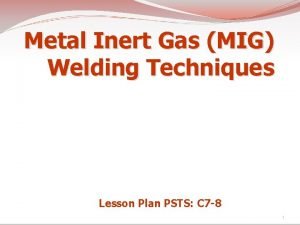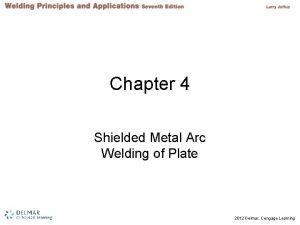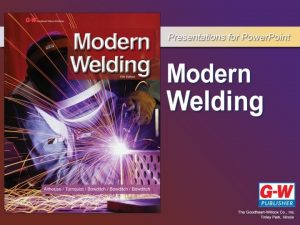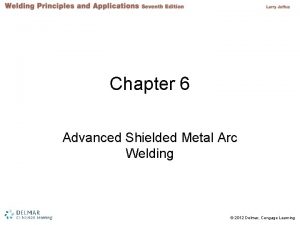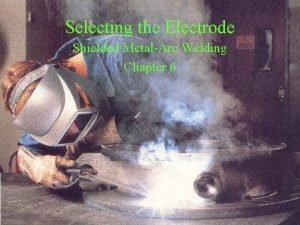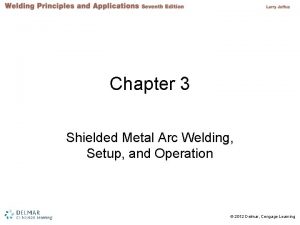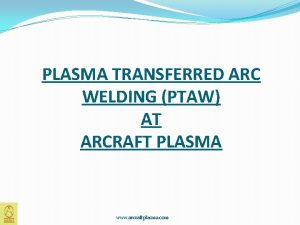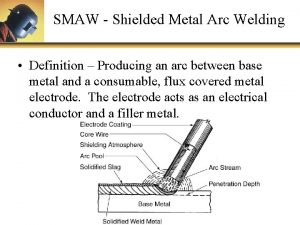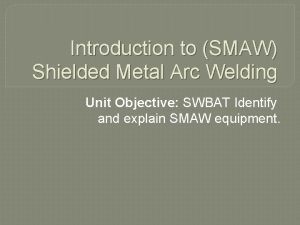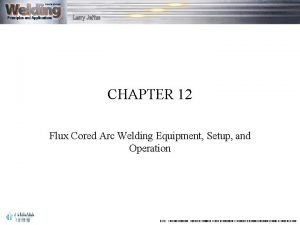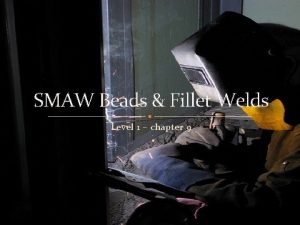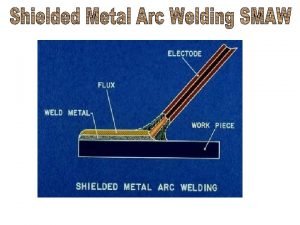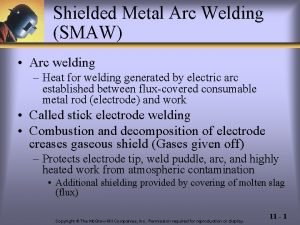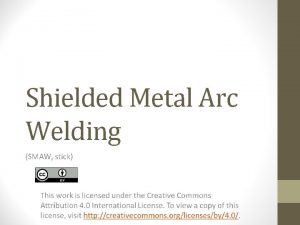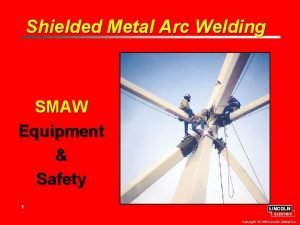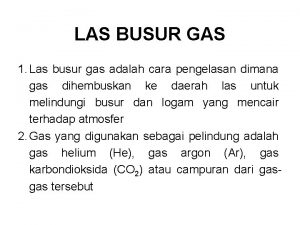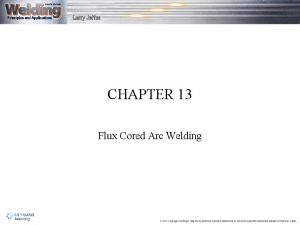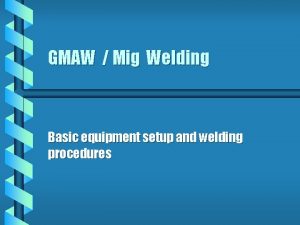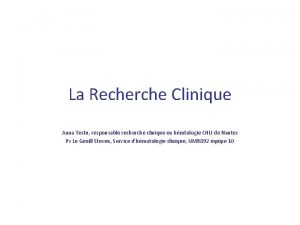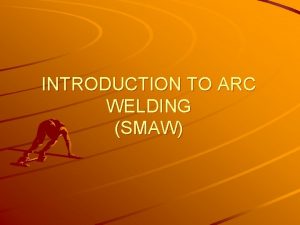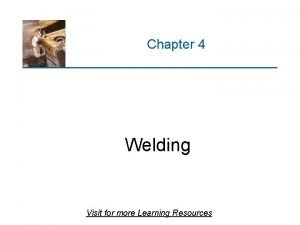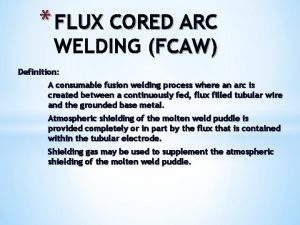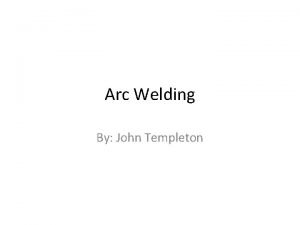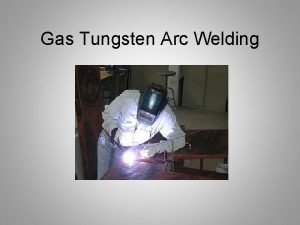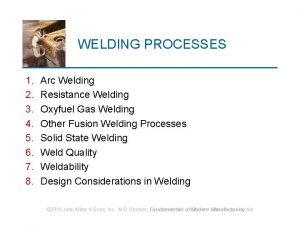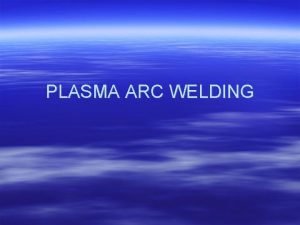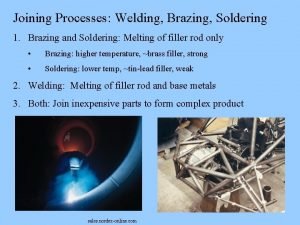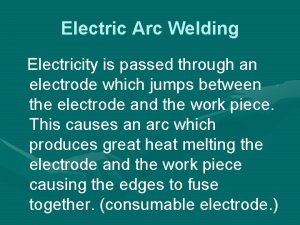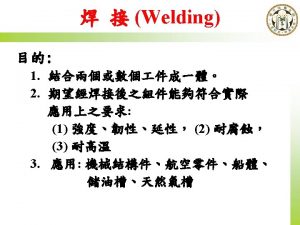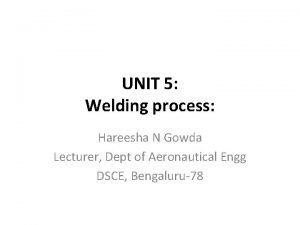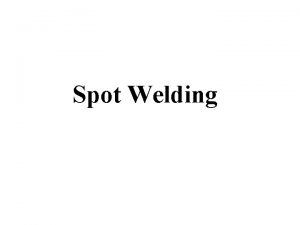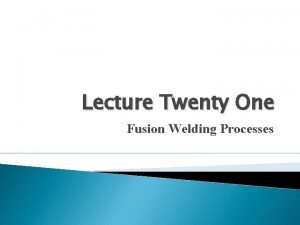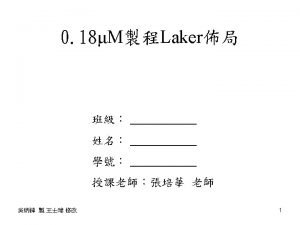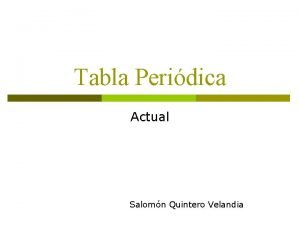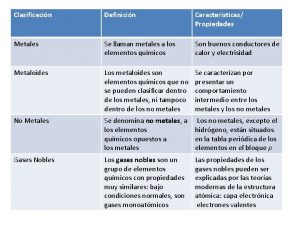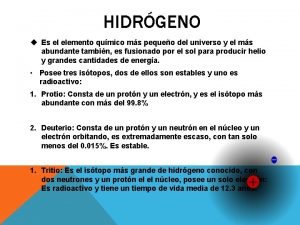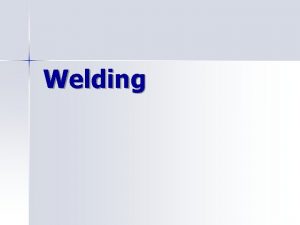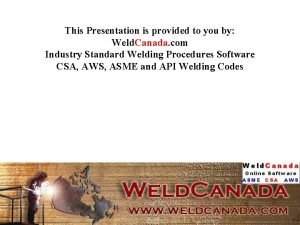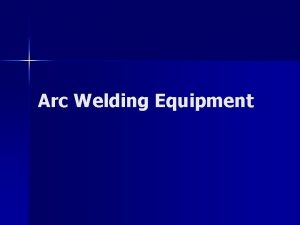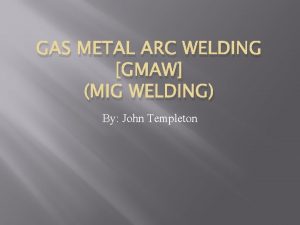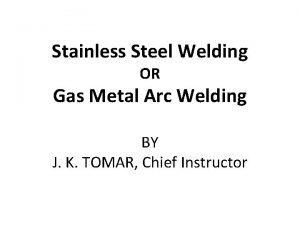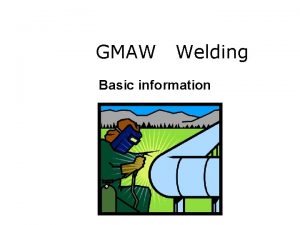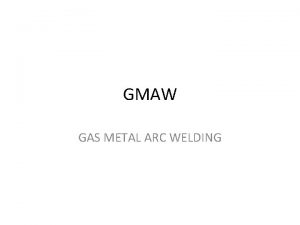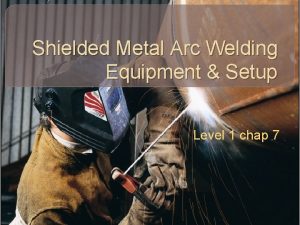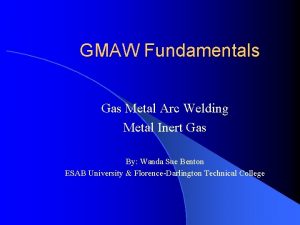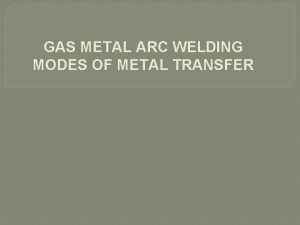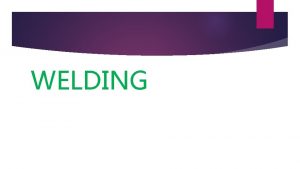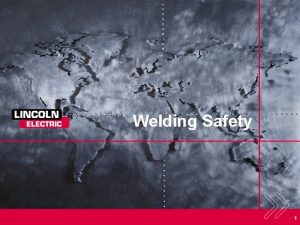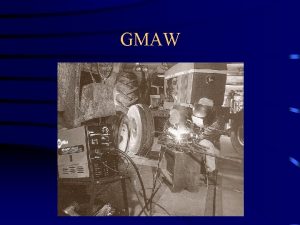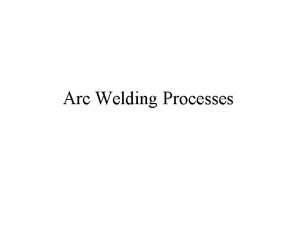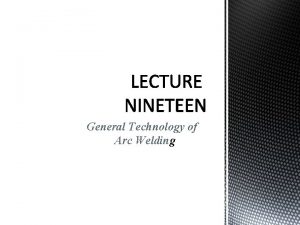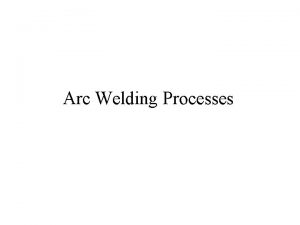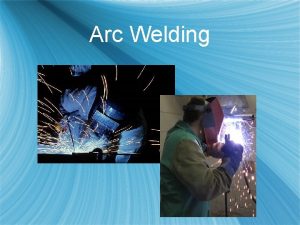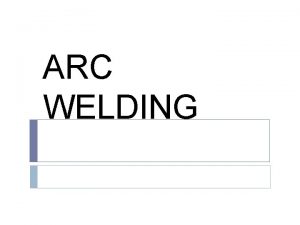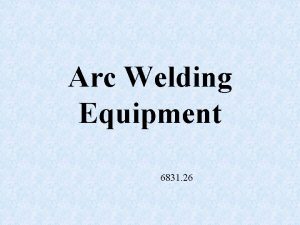CHAPTER 10 Gas Metal Arc Welding Equipment Setup























































- Slides: 55

CHAPTER 10 Gas Metal Arc Welding Equipment, Setup, and Operation

OBJECTIVES • After completing this chapter, the student should be able to – discuss the various methods of metal transfer including the axial spray metal transfer process, globular transfer, pulsed-arc metal transfer, buried-arc transfer, and short-circuiting transfer GMAW-S. – list shielding gases used for short-circuiting, spray, and pulsed-spray transfer. – describe the more commonly used GMA welding filler metals. – define deposition efficiency, and tell how a welder can control the deposition rate. – define voltage, electrical potential, amperage, and electrical current as related to GMA welding.

OBJECTIVES (cont. ) • After completing this chapter, the student should be able to – tell how wire-feed speed is determined and what it affects. – discuss how the GMAW molten weld pool can be controlled by varying the shielding gas, power settings, weave pattern, travel speed, electrode extension, and gun angle. – describe the backhand forehand welding techniques. – list and describe the basic GMAW equipment. – explain how the arc spot weld produced by GMAW differs from electric resistance spot welding and the advantages of GMA spot welding.

KEY TERMS • • • axial spray metal transfer buried-arc transfer electrode extension (stickout) globular transfer pinch effect pulsed-arc metal transfer short-circuiting transfer slope synergic systems transition current

INTRODUCTION • In the 1920 s, a metal arc welding process using an unshielded wire was being used to assemble the rear axle housings for automobiles. – The shielded metal arc welding electrode made a much higher-quality weld. In 1948, the first inert gas metal arc welding (GMAW) process, as it is known today, was developed and became commercially available, Figure 10 -1.

INTRODUCTION (cont. ) • MIG, which is short for metal inert gas welding, • MAG, which is short for metal active gas welding, and • wire welding, which describes the electrode used. – The GMAW process may be performed as semiautomatic (SA), machine (ME), or automatic (AU) welding, Table 10 -1.

INTRODUCTION (cont. ) – Table 10 -2 shows the typical weld deposition rates using the GMA welding process. The increased usage has led to a reduction in the cost of equipment. GMA welding equipment is now found even in small shops.

WELD METAL TRANSFER METHODS • The GMAW process is unique in that there are six modes of transferring the filler metal from the wire to the weld. • The modes of metal transfer are: – – – Short-circuiting transfer (GMAW-S), Axial spray transfer, Globular transfer, Buried-arc transfer, Pulsed-arc transfer (GMAW-P), Modulated current

SHORT-CIRCUITING TRANSFER (GMAW-S) • Low currents allow the liquid metal at the electrode tip to be transferred by direct contact with the molten weld pool. • This process requires close interaction between the wire feeder and the power supply. • This technique is called short-circuiting transfer • The short-circuiting mode of transfer is the most common process used with GMA welding • • on thin or properly prepared thick sections of material, on a combination of thick to thin materials, with a wide range of electrode diameters, and with a wide range of shielding gases.

SHORT-CIRCUITING TRANSFER (GMAW-S) (cont. ) • The 0. 023, 0. 030, 0. 035, and 0. 045 wire electrodes are the recommended diameters for the short-circuiting mode. • Shielding gas used on carbon steel is carbon dioxide (CO 2) or a combination of 25% CO 2 and 75% argon (Ar). • The amperage range may be as low as 35 for materials of 24 gauge or as high as 225 for materials up to 1/8 in. (3 mm) in thickness on square groove weld joints. • Thicker base metals can be welded if the edges are beveled to accept a complete joint weld penetration.

SHORT-CIRCUITING TRANSFER (GMAW-S) (cont. ) • To start this process, the wire is in direct contact with the molten weld pool, Figure 10 -3 A. • Once the electrode touches the molten weld pool, the arc and its resistance are removed. • Without the arc resistance, the welding amperage quickly rises as it begins to flow freely through the tip of the wire into the molten weld pool.

SHORT-CIRCUITING TRANSFER (GMAW-S) (cont. ) • The resistance to current flow is highest at the point where the electrode touches the molten weld pool. • The resistance is high because both the electrode tip and weld pool are very hot. • The higher the temperature, the higher the resistance to current flow. • A combination of high current flow and high resistance causes a rapid rise in the temperature of the electrode tip.

SHORT-CIRCUITING TRANSFER (GMAW-S) (cont. ) • As the current flow increases, the interface between the wire and molten weld pool is heated until it explodes into a vapor (Figure 10 -3 B), establishing an arc. This small explosion produces sufficient force to depress the molten weld pool.

SHORT-CIRCUITING TRANSFER (GMAW-S) (cont. ) • A gap between the electrode tip and the molten weld pool (Figure 10 -3 C) immediately opens. • With the resistance of the arc reestablished, the voltage increases as the current decreases. • The low current flow is insufficient to continue melting the electrode tip off as fast as it is being fed into the arc.

SHORT-CIRCUITING TRANSFER (GMAW-S) (cont. ) • As a result, the arc length rapidly decreases (Figure 10 -3 D) until the electrode tip contacts the molten weld pool (Figure 10 -3 E). • The liquid formed at the wire tip during the arc-on interval is transferred by surface tension to the molten weld pool, and the cycle begins again with another short circuit

GLOBULAR TRANSFER • Globular transfer is generally used on thin materials and at a very low current range. • In the globular transfer, the arc melts the end of the electrode, forming a molten ball of metal.

AXIAL SPRAY TRANSFER • The axial spray metal transfer mode produces high deposition rates with almost spatter free welds, Figure 10 -5. • This process is identified by the pointing of the wire tip from which very small drops are projected (sprayed) axially across the arc gap to the molten weld pool.

AXIAL SPRAY TRANSFER • There are hundreds of drops per second crossing from the wire to the base metal. • These drops are propelled by arc forces at high velocity in the direction the wire is pointing. • This projection of drops enables welding in the vertical and overhead positions, if the weld size is kept small, without losing control of transfer.

AXIAL SPRAY TRANSFER (cont. ) • This spray transfer process requires three conditions: argon shielding (or argon-rich shielding gas mixtures), DCEP polarity, and a current level above a critical amount called the transition current. • The shielding gas is usually a mixture of 95% to 98% argon and 2% to 5% oxygen. • The added percentage of oxygen allows greater weld penetration.


PULSED-ARC TRANSFER (GMAW-P) • The current produced by the pulsed-arc metal transfer (GMAW-P) mode is a dual pulsed current. • One pulse of high current is for the axial spray transfer mode, and the other lower pulse of current should not transfer any weld metal.

PULSED-ARC TRANSFER (GMAW-P) (cont. ) • The high current of the spray mode produces good penetration and fusion, and the low current allows the weld pool to cool and contract slightly, so it is easier to control. • The ease of controlling the weld is a major advantage of GMAW-P. Experienced GMA welders can pick up this variation quickly, and new welders often can develop their skills faster on GMAW-P than on traditional GMA welding

PULSED-ARC TRANSFER (GMAW-P) (cont. ) • The graph in Figure 10 -7 shows the pulsed-arc metal transfer current cycle and identifies the eight components: • Ramp up • Overshoot • High pulse current • High pulse time • Ramp down • Step-off current • Background current • Pulse width

PULSED-ARC TRANSFER (GMAW-P) (cont. )


MODULATED CURRENT • Several manufacturers sell welding equipment designed for the highly specialized welding current profile needed to perform modulated current transfer welding. • They all have their own trade names for their version of the modulated current transfer process. • There are some differences in how each manufacturer’s systems operate, but theory used to reduce spatter and increase fusion while controlling heat input is similar. • In these systems the wire feed speed is constant and the welding current is modulated, controlled up and down, at the same rate that metal is being transferred. • The control of the modulated current process is far more sophisticated that the traditional GMAW-P process

MODULATED CURRENT (cont. ) • During the welding the computer senses several steps including: – When the droplet of molten metal is almost ready to separate from the filler wire and instantly reduces the welding current, as shown by the sharp drop in current between Figure 10 -10 C and 10 -10 D.

MODULATED CURRENT (cont. ) – Once the arc has been reestablished, the computer increases the current back to the higher level for a softer restarting of the arc. – The higher current level of the reestablished arc allows it to melt back the filler metal to form a molten ball of metal on the end. – After the molten ball is created, the current level is reduced so the end of the wire and molten ball are pushed downward into the molten weld pool.

MODULATED CURRENT (cont. ) • Advantages of Modulated Current and Pulsed-Arc Metal Transfer • The there a number of advantages that both modulated current and pulsed-arc metal transfer provide to GMA welding. – – – – – Lower Heat Input Less distortion Deep Penetration Higher Travel Speeds Poor fit-up Reduced High transfer efficiency Lower fume production High-quality welds Arc blow resistant • Welders find the welding environment with little spatter, fumes, and reduced heat more pleasant to work in than most other welding processes.

BURIED-ARC TRANSFER • The arc in carbon dioxide is very forceful. Because of this, the wire tip can be driven below the surface of the molten weld pool.

WIRE MELTING AND DEPOSITION RATES • The wire melting rates, deposition rates, and wire-feed speeds of the consumable wire welding processes are affected by the same variables. • Deposition efficiencies depend on the process, on the gas used, and even on how the welder sets welding conditions. With efficiencies of approximately 98%, solid wires with argon shields are best.


WELDING POWER SUPPLIES • To better understand terminology used to describe the different welding power supplies, you need to know the following electrical terms: – Voltage, or volts (V), is a measurement of electrical pressure, in the same way that pounds per square inch is a measurement of water pressure. – Electrical potential means the same thing as voltage and is usually expressed by using the term potential (P). The terms voltage, volts, and potential can all be interchanged when referring to electrical pressure. – Amperage, or amps (A), is the measurement of the total number of electrons flowing, in the same way that gallons are a measurement of the amount of water flowing. – Electrical current means the same thing as amperage and is usually expressed by using the term current (C). The terms amperage, amps, and current can all be interchanged when referring to electrical flow.

GMA WELDING MACHINES • GMAW power supplies are the constant-voltage, constantpotential (CV, CP)-type machines, unlike SMAW power supplies, which are the constant-current (CC)-type machines and are sometimes called drooping arc voltage (DAV). • Speed of the Wire Electrode – The wire-feed speed is generally recommended by the electrode manufacturer and is selected in inches per minute (ipm), or how fast the wire exits the contact tube. • Power Supplies for Short-Circuiting Transfer – Although the GMA power source is said to have a constant potential (CP), it is not perfectly constant. The graph in Figure 10 -14 shows that there is a slight decrease in voltage as the amperage increases within the working range. – The machine slope is affected by circuit resistance. Circuit resistance may result from a number of factors, including poor connections, long leads, or a dirty contact tube.

SHIELDING GAS • The shielding gas selected for a weld has a definite effect on the weld produced. • The properties that can be affected include the method of metal transfer, welding speed, weld contour, arc cleaning effect, and fluidity of the molten weld pool. • Argon gas blends • Helium • Carbon dioxide • Nitrogen

SHIELDING GAS (cont. )

SHIELDING GAS (cont. )


POWER SETTINGS • As the power settings, voltage, and amperage are adjusted, the weld bead is affected. – Making an acceptable weld requires a balancing of the voltage and amperage. • Increasing and decreasing the voltage changes the arc length but may not put more heat into the weld. – Like changes in the amperage, these voltage changes may decrease weld penetration.

WEAVE PATTERN • The GMA welding process is greatly affected by the location of the electrode tip and molten weld pool. • During the short-circuiting process if the arc is directed to the base metal and outside the molten weld pool, the welding process may stop. • Without the resistance of the hot molten metal, high amperage surges occur each time the electrode tip touches the base metal, resulting in a loud pop and a shower of sparks. • It is something that occurs each time a new weld is started.

TRAVEL SPEED • Because the location of the arc inside the molten weld pool is important, the welding travel speed cannot exceed the ability of the arc to melt the base metal. • Too high a travel speed can result in overrunning of the weld pool and an uncontrollable arc.

ELECTRODE EXTENSION • The electrode extension (stickout) is the distance from the contact tube to the arc measured along the wire.

ELECTRODE EXTENSION (cont. )

GUN ANGLE • The gun angle, work angle, and travel angle are names used to refer to the relation of the gun to the work surface. The gun angle can be used to control the weld pool.

FOREHAND/PERPENDICULAR/BACKHAND WELDING • Forehand, perpendicular, and backhand are the terms most often used to describe the gun angle as it relates to the work and the direction of travel. • The forehand technique is sometimes referred to as pushing the weld bead, Figure 10 -21 A, and backhand may be referred to as pulling or dragging the weld bead, Figure 1021 C. • The term perpendicular is used when the gun angle is at approximately 90° to the work surface, Figure 10 -21 B.

METAL CORE ELECTRODES FOR GMA WELDING • Metal core electrodes are made much like the tubular electrodes used in flux cored arc welding. • The addition of the powdered metal in the core increases buildup for higher welding speeds and adds to the arc stability resulting in a smoother arc with a reduction in spatter. • Metal core electrodes can be used in any position and on joints that have larger or uneven root openings. • The metal core electrode’s smoother are allow it to be used on thin sheet metal without melt through

EQUIPMENT • The basic GMAW equipment consists of the gun; electrode (wire) feed unit; electrode (wire) supply; power source; shielding gas supply with flowmeter/regulator; control circuit; and related hoses, liners, and cables, Figure 10 -24.

POWER SOURCE • The power source may be either a transformer-rectifier or generator type. • The welding machine produces a DC welding current ranging from 40 amperes to 600 amperes with 10 volts to 40 volts, depending upon the machine.

ELECTRODE (WIRE) FEED UNIT • The purpose of the electrode feeder is to provide a steady and reliable supply of wire to the weld. Slight changes in the rate at which the wire is fed have distinct effects on the weld. • Push-Type Feed System • Pull-Type Feed System • Push-Pull–Type Feed System • Linear Electrode Feed System • Spool Gun

ELECTRODE CONDUIT • The electrode conduit or liner guides the welding wire from the feed rollers to the gun. It may be encased in a lead that contains the shielding gas.

WELDING GUN • The welding gun attaches to the end of the power cable, electrode conduit, and shielding gas hose.

GMA SPOT WELDING • GMA can be used to make high-quality arc spot welds. Welds can be made using standard or specialized equipment. • GMA spot welding has some advantages such as the following: (1) welds can be made in thin-to-thick materials; (2) the weld can be made when only one side of the materials to be welded is accessible; and (3) the weld can be made when there is paint on the interfacing surfaces. The arc spot weld can also be used to assemble parts for welding to be done at a later time.



SUMMARY • The keys to producing quality GMA welds are equipment, setup, and adjustments. • Once you have mastered these skills, the only remaining obstacle to your producing consistent, uniform, high-quality welds is your ability to follow, or track, the joint consistently. • Selecting the proper method of metal transfer—short arc, globular, or axial spray—is normally done by the welding shop foreman or supervisor.
 The shielded metal arc welding machines voltage output
The shielded metal arc welding machines voltage output Mig welding patterns
Mig welding patterns Chill plate welding definition
Chill plate welding definition Dcen in welding
Dcen in welding Chapter 6 advanced shielded metal arc welding
Chapter 6 advanced shielded metal arc welding Fill freeze electrode examples
Fill freeze electrode examples Chapter 3 shielded metal arc welding
Chapter 3 shielded metal arc welding Plasma transferred arc welding equipment
Plasma transferred arc welding equipment Smaw definition
Smaw definition Smaw introduction
Smaw introduction Globular transfer welding
Globular transfer welding Procedure of stringer bead in flat position
Procedure of stringer bead in flat position Smaw electrode classification
Smaw electrode classification Advantage of smaw
Advantage of smaw Shielded metal arc welding definition
Shielded metal arc welding definition Smaw tools
Smaw tools Las busur gas
Las busur gas Fca welding practice plates thicker than 1/2 inch ____.
Fca welding practice plates thicker than 1/2 inch ____. Gmaw setup
Gmaw setup Arc promoteur vs arc investigateur
Arc promoteur vs arc investigateur Parts of a circle
Parts of a circle The minor arc
The minor arc Arc emu88 com arc info 45 100045 html
Arc emu88 com arc info 45 100045 html Smaw definition
Smaw definition Carbon arc welding
Carbon arc welding History of arc welding
History of arc welding Fcaw welding process
Fcaw welding process Welding objectives
Welding objectives Joan of arc map
Joan of arc map Preflow welding definition
Preflow welding definition Welding safety quiz
Welding safety quiz Coalescence welding definition
Coalescence welding definition Paw welding process
Paw welding process Resistance arc welding
Resistance arc welding Principle of electric arc welding
Principle of electric arc welding Diffusion bonding
Diffusion bonding Welding principles
Welding principles Welding learning objectives
Welding learning objectives Fusion arc welding
Fusion arc welding Joint design in welding
Joint design in welding Diagram of the states of matter
Diagram of the states of matter Properties of metals nonmetals and metalloids
Properties of metals nonmetals and metalloids Dp periodic table
Dp periodic table Melting point of nonmetals
Melting point of nonmetals Deep n well
Deep n well Metal and non metal difference between
Metal and non metal difference between Is sulfer a metal nonmetal or metalloid
Is sulfer a metal nonmetal or metalloid Ionic compounds have
Ionic compounds have Grupo b tabla periódica
Grupo b tabla periódica Spraggins fitness
Spraggins fitness Oxigeno caracteristicas y propiedades
Oxigeno caracteristicas y propiedades Examples of metal
Examples of metal Hidrgeno
Hidrgeno Tungsten inert gas welding
Tungsten inert gas welding Welding robot introduction
Welding robot introduction Gas welding conclusion
Gas welding conclusion

